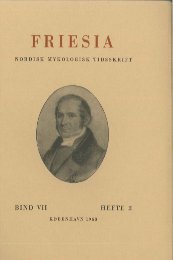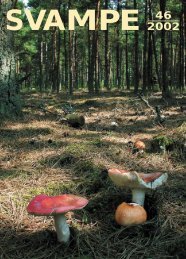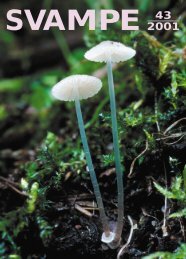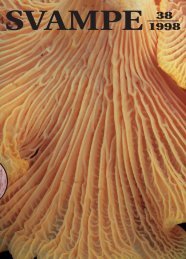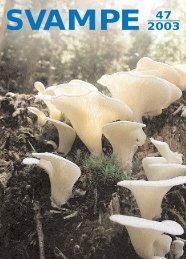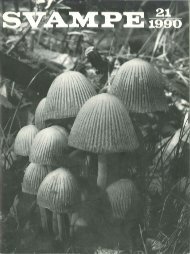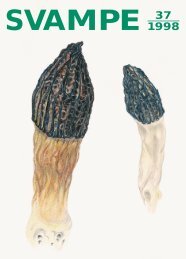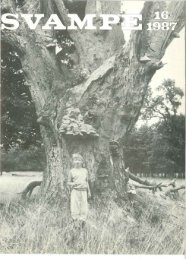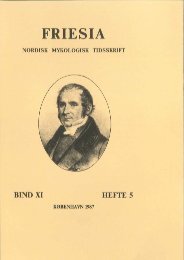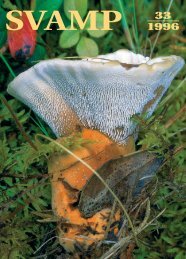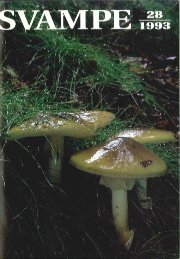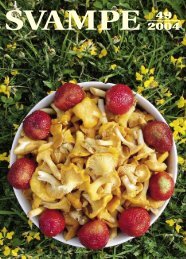Friesia X, 4-5
Friesia X, 4-5
Friesia X, 4-5
You also want an ePaper? Increase the reach of your titles
YUMPU automatically turns print PDFs into web optimized ePapers that Google loves.
- 266-<br />
levis, septatis, interdum semel or bis furcati, 1000-1 500 X 5-6.5 m zz ,<br />
apice hebetes, dilute coloratis, (b) brevis, arcuat is, septatis, levis ad<br />
indistincto asperatus, 175-280 X 3.0-3.5 m zz, aliquot irregulariter ramosis,<br />
apice hebetes. Pilis lateralibus pauci, brevis, r ectis, 200-260 X<br />
2.5-3.5 mzz, Ascis clavatis, octosporis, evanescentibus, 35-40 X 8-11 m zz ,<br />
Ascosporis biseriatis vel tendentes ad duplicem seriem, pallido-brunneis,<br />
ellipsoideis, subapiculatis, guttulat is, germinat ionis poris ad<br />
unum apicem, 6.5-7.5 X 4.8-5.0 m zz .<br />
Ty pus leetus a N. SlNGH in stercore Cervus axis in horto zoologico<br />
ad Delhi 12.5.1972. Dry cult ura holotypus posit us in Herb ario myc ologico<br />
, sectione botanica, universitatis Delhi, sub numero DU /KS 190.<br />
Colonies mo derately growing on Oat meal agar, 2.0-2.5 cm in<br />
seven days at 27 ± 10 C, forming gr owth rings of white sterile mycelia<br />
and black perithecia. On Rabbit dung agar it for ms whit e my celia<br />
with scattered or aggregated black perithecia.<br />
Perithecia superficial , black, semitranslucent, groups of asci can<br />
be seen through the wall, globose to subglobose, 120-150 X 110<br />
120 m ,« ; attached to the substratum by delicate rhizoids, 50-80 X 2.0<br />
2.5 m zz; ostiolate, producing at maturity a cirrhus of spore mass<br />
much bigger in size than the perithecial body itself, entangled in the<br />
terminal hairs, 160-200 X 170-260 m,« (Figs. 1, 5) . Terminal hairs are<br />
distinctly of two t ypes (Fig. 1 [ar r ow] , 7-9): (a) very long, straight<br />
to spreading, sometimes with geniculations on its surface, smooth,<br />
septate rarely once or twice, greyish-brown in colour, 1000-1500 X<br />
5.0-6.5 m,« , thick walled, upto 0.5 mp in diameter, tips blunt and light<br />
coloured; (b) short incurved or arcuate, recurved, some irregularly<br />
branched, smooth, to indistinctly rough, septate, 175-280 X 3.00<br />
3.5 m,«. Both the types of terminal hairs originating around the<br />
ostiole and sometimes at maturity the whole crown of terminal hairs<br />
gets detached from the perithecium (Fig. 6). Lateral hairs few,<br />
short, upto 100-260 X 2.5-3.5 m,«. Asci clavate, 8-spored, evanescent,<br />
35-40 X 8-11 m zz, with narrow stipe (Figs. 4, 11). Ascospores biseriate<br />
to irregular, light brown, ellipsoid, subapiculate, 6.5-7.5 X 4.8-5.0 m,« ,<br />
guttulate, with an apical germ pore (Figs. 3, 11).<br />
Perithecia become empty and partly transparent after the release<br />
of the asci and ascospores (Fig. 2).<br />
The form was isolated from Sambhar deer dung collected from<br />
New Delhi zoo on 12.5.1972. Type cultures of the fungus have been<br />
deposited in the Commonwealth Mycological lnstitute, Kew, England,<br />
and also at the Indian Type Culture Collection, lARI, New Delhi 12.



